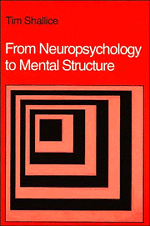Book contents
- Frontmatter
- Contents
- Preface
- I Introducing Cognitive Neuropsychology
- II Converging Operations: Specific Syndromes and Evidence from Normal Subjects
- 3 The Short-Term Memory Syndrome
- 4 The Peripheral Dyslexias
- 5 The Central Dyslexias
- 6 The Agraphias
- 7 Language Operations: Are Input and Output Processes Separate?
- 8 The Generality of the Approach: The Case of Visual Perception
- III Inferences from Neuropsychological Findings
- IV Central Processes: Equipotentiality or Modularity?
- References
- Subject Index
- Author Index
- Index of Patients Cited
7 - Language Operations: Are Input and Output Processes Separate?
from II - Converging Operations: Specific Syndromes and Evidence from Normal Subjects
Published online by Cambridge University Press: 21 October 2009
- Frontmatter
- Contents
- Preface
- I Introducing Cognitive Neuropsychology
- II Converging Operations: Specific Syndromes and Evidence from Normal Subjects
- 3 The Short-Term Memory Syndrome
- 4 The Peripheral Dyslexias
- 5 The Central Dyslexias
- 6 The Agraphias
- 7 Language Operations: Are Input and Output Processes Separate?
- 8 The Generality of the Approach: The Case of Visual Perception
- III Inferences from Neuropsychological Findings
- IV Central Processes: Equipotentiality or Modularity?
- References
- Subject Index
- Author Index
- Index of Patients Cited
Summary
Separate or Common Input and Output Processes: Are the Two Empirically Distinguishable?
The last three chapters have been concerned with the application of the cognitive neuropsychology method to whole domains, not just with the isolation of individual subsystems. Yet if some form of modularity framework is assumed as a general design principle for cognition, the conclusion that the orthographic, phonological, and semantic analyses of words should be conducted by functionally distinct subsystems is not too surprising. The sights, sounds, and meanings of words are phenomenologically very different. If one were to design a system to categorise words orthographically from the output of earlier visual processing, another to categorise them phonologically from the output of earlier auditory processing, and a third to specify them semantically from the outputs of the orthographic and phonological analyses, then the computational requirements of the three processes would be sufficiently distinct to make a modular ‘solution’ plausible.
In this chapter, an issue will be addressed for which general design principles and phenomenology do not provide any obvious answer. What is the relation between the sets of conclusions reached in chapters 5 and 6? To put it more generally, are the central representations and processes used by output systems the same as those used by input systems? On the claims being made for the cognitive neuropsychology method, this is just the sort of question that the approach should be suited to answer.
- Type
- Chapter
- Information
- From Neuropsychology to Mental Structure , pp. 158 - 182Publisher: Cambridge University PressPrint publication year: 1988



